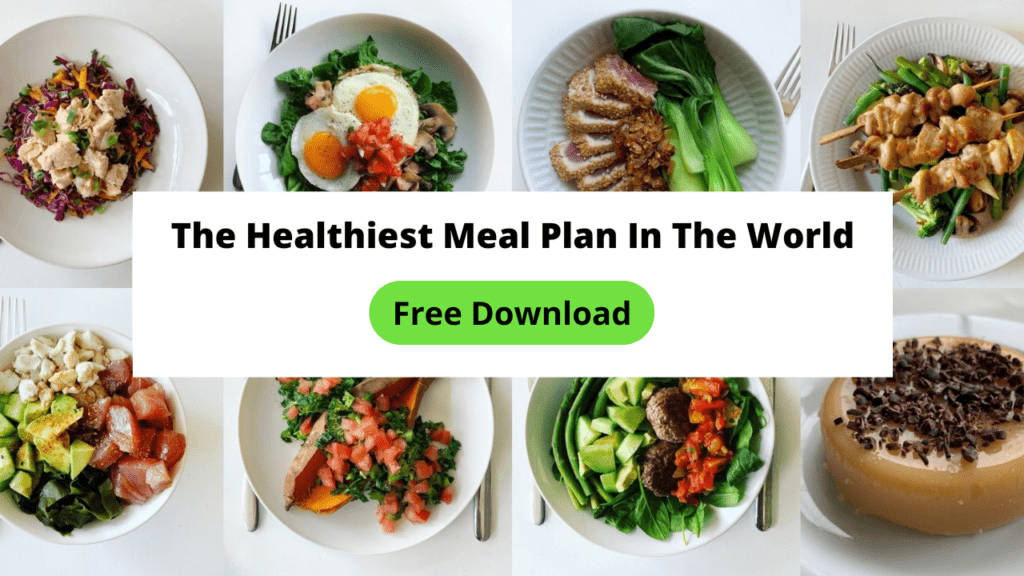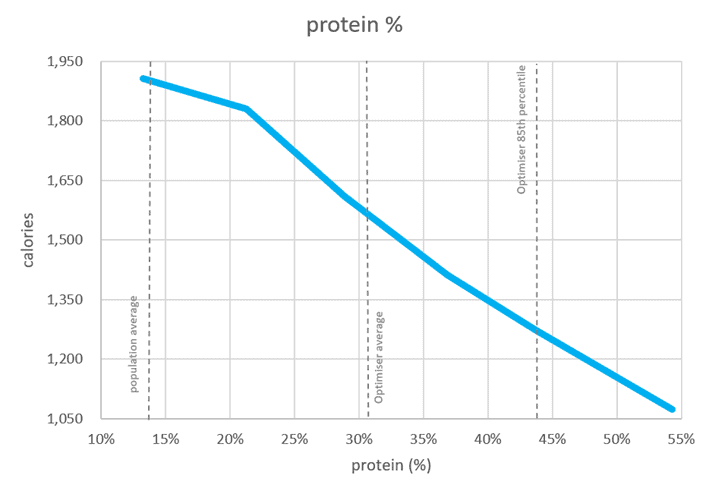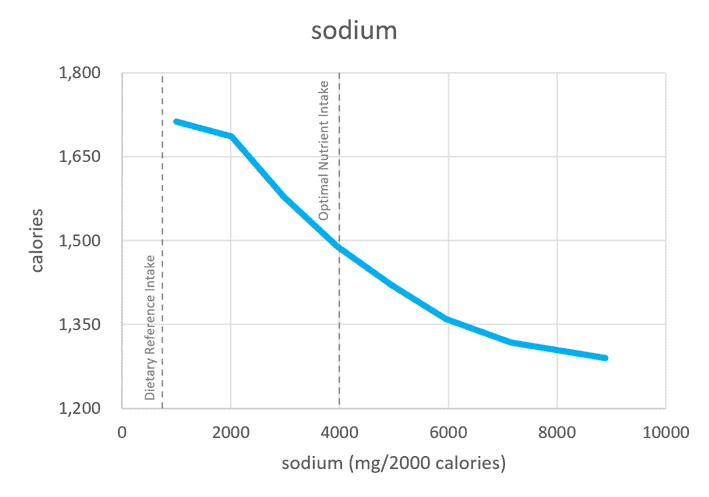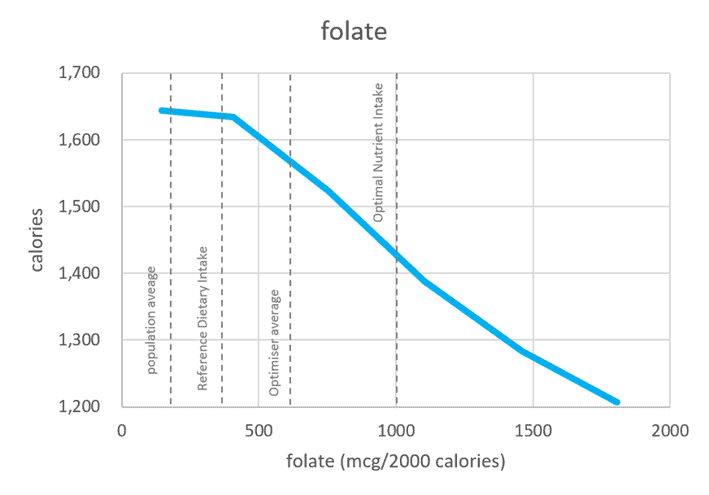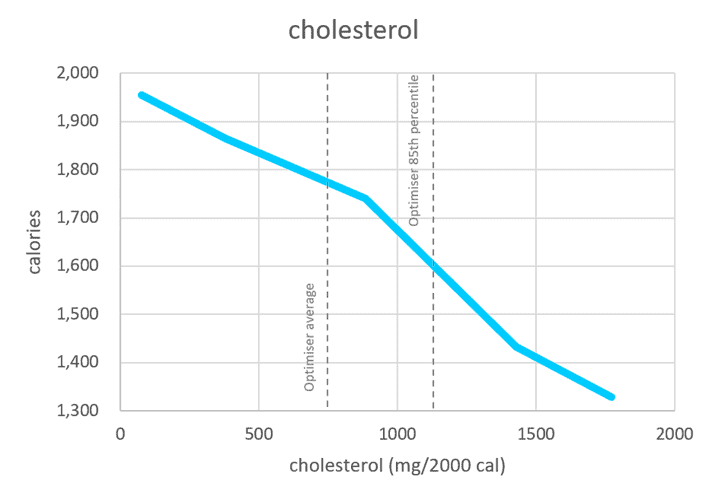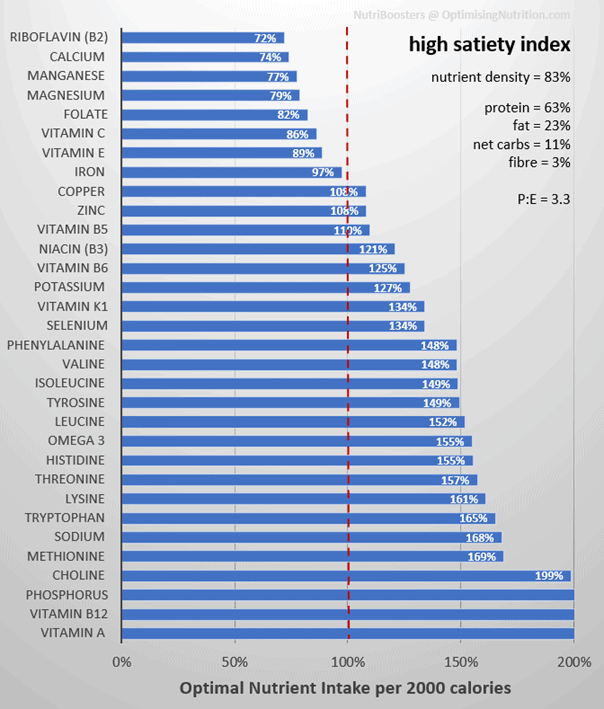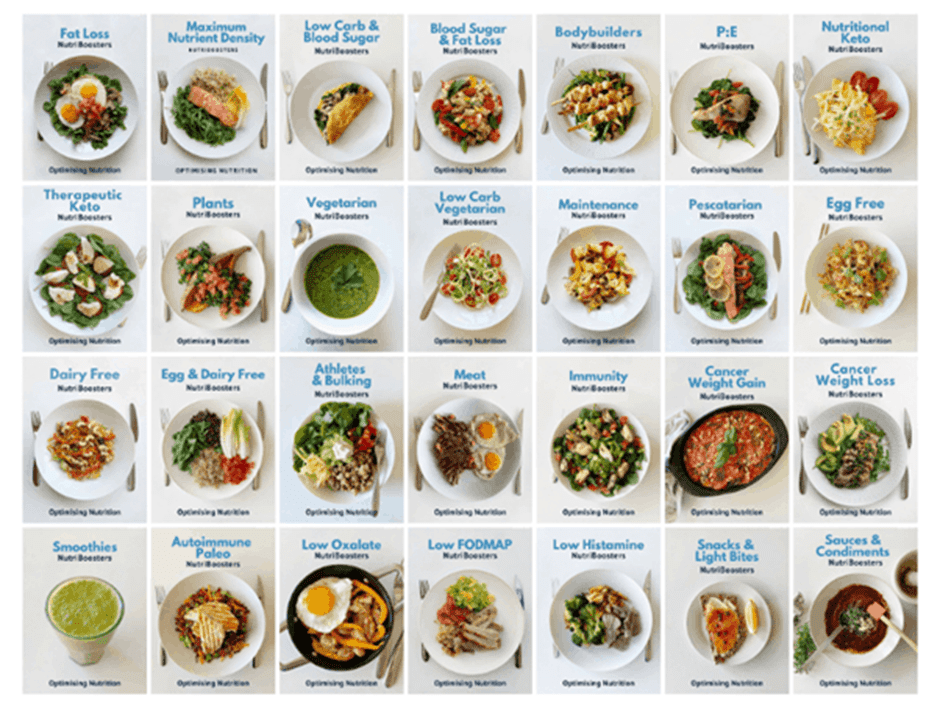Satisfying your cravings with fewer calories and less hunger is the Holy Grail of weight loss and the key to successful long-term dieting.
High-satiety meals not only fill you up for the short term but also provide you with all the micronutrients you need over the long term to satisfy your cravings and quell your appetite.
High-satiety meals allow you to sustain an energy deficit with less hunger. This is a critical but often under-appreciated factor in weight loss.
We’ve been on a five-year data-driven mission to quantify satiety and empower people to make more informed choices so they can eat fewer calories with less hunger.
To get you started on your journey of Nutritional Optimisation, this article showcases some of our highest-satiety meals and recipes from our database of over 600 NutriBooster recipes.
What Are the Most Satiating Meals?
To help boost your satiety right away, we’ve included ten meals from our database of NutriBooster recipes scoring the highest on our satiety index. Click on the link above each photo to see the full recipe and the details of the energy, macro, and micronutrient for each recipe.
Turkey and Spinach Omelette
Popeye Bowl
Lean Burgers, Spinach, and Mushrooms
Prawn, Salmon, Shiitake and Cabbage Stir Fry
Blackened Fish Stir Fry
Steak, Mushrooms, and Asparagus
Carne Asada Burrito
Puttanesca Fish on Chard
Lettuce Wrap with Prawn Salsa
Steak, Egg, Spinach and Tomato
Are you interested in learning more about how we determined our ‘maximum satiety’ rankings? Then keep reading.
What Is Satiety?
Satiety is the sensation of fullness you feel after eating.
A satiating meal keeps you satisfied for longer, allowing you to consume fewer calories.
What Makes a Meal Satiating?
Our analysis of 125,761 days of food logging data from 34,519 people using Nutrient Optimiser has shown that meals with more amino acids and a handful of other critical micronutrients like potassium, calcium, sodium, folate and fibre keep us feeling fuller for fewer calories. These meals give our bodies the nutrients to function with less energy. In other words, more ‘nutrient bang for your energy buck’.
Protein
As the chart below from our satiety analysis shows, we eat fewer calories when our meals have a higher protein % and contain less energy from fat and non-fibre carbohydrates.
It is well established in published research that a higher protein % aligns with greater satiety. This is also known as the protein leverage hypothesis.
However, our analysis showed that it’s not just the amino acids in protein that satisfy our cravings for fewer calories; we see a similar satiety response to other essential vitamins, minerals, and fatty acids.
Rather than a strict protein leverage phenomenon, we see widespread nutrient leverage at play.
Minerals
The chart below shows that we consume fewer calories when we consume more foods and meals that contain more potassium per calorie.
We also see a similar trend with other minerals like sodium and calcium.
Additionally, we appear to have a satiety response to the vitamins in our food, like folate, as shown in the satiety response chart below.
While this information might have you heading to Amazon to load up your cart with bottles of these supplements, I need to point out that the effects of taking a multivitamin pill for nutritional insurance vs eating these foods are not the same.
Unfortunately, we only see the benefits when we eat all the nutrients together from whole foods.
Fibre
Our satiety analysis also shows that fibre positively influences satiety. However, you won’t get this from choking down more Metamucil supplements! Instead, we see a statistically significant satiety response when people consume more fibre per calorie.
Cholesterol
Cholesterol is a nutrient that has had a chequered history. Until the 2015 Dietary Guidelines exonerated it as no longer a nutrient of concern, it was typically recommended to try to minimise cholesterol due to the belief that cholesterol in the diet raised cholesterol in the blood. However, as shown in the satiety response chart below, Optimisers who consume per cholesterol per calorie tend to consume 39% fewer calories!
How Did We Calculate the Satiety Index?
While all of the essential micronutrients tend to align with greater satiety, our Optimiser data analysis has enabled us to identify the critical nutrients that have been shown to impact satiety the most.
The table below shows the results of our multivariate analysis and the calorie reduction that aligns with consuming more or less of each particular nutrient. As you can see, protein influences satiety the most, but the other vitamins and minerals also play a significant role.
| Nutrient | Units | 15th | 85th | calories | % |
| protein | % | 19% | 44% | -390 | -25.0% |
| cholesterol | mg/2000 cal | 229 | 1019 | -124 | -7.9% |
| sodium | mg/2000 cal | 1404 | 5015 | -101 | -6.4% |
| folate | mg/2000 cal | 162 | 993 | -93 | -6.0% |
| fibre | g/2000 cal | 10 | 43 | -92 | -5.9% |
| potassium | mg/2000 cal | 1806 | 6051 | -77 | -4.9% |
| calcium | mg/2000 cal | 442 | 1833 | -76 | -4.8% |
| total | -952 | -61% |
While increasing the protein % of your diet aligns with a 25% reduction in calories, dialling in all the other nutrients represents a massive 36% reduction in calories!
With this more in-depth understanding of our satiety response to various nutritional properties of food, we can estimate how many calories a typical person would consume of a particular food or meal if that’s all they ate in a day. We can then rank foods or meals and use them to calculate a unique satiety index score.
Nutrient Density of High Satiety Index NutriBooster Recipes
Because our satiety index emphasises other micronutrients in addition to protein, all the recipes with the highest satiety index scores tend to have evenly distributed nutrient profiles. The chart below shows the micronutrient profile of our highest-satiety NutriBooster recipes.
However, as the following micronutrient fingerprint shows, our nutrient profile improves even further when we emphasise all of the micronutrients—not just the ones our analysis shows are the most critical for satiety!
The NutriBooster recipes with the highest Nutrient Density Scores are also lower in protein (51% vs 63%). Because protein is so satiating, these meals might be a little easier to consume over the long term than those with the highest satiety.
Satiety Index vs Nutrient Density
Because nutrient-dense foods and meals satisfy your nutrient cravings with fewer calories, there is some correlation between satiety and nutrient density. The chart below shows the satiety index score vs Nutrient Density Score for all of our NutriBooster recipes.
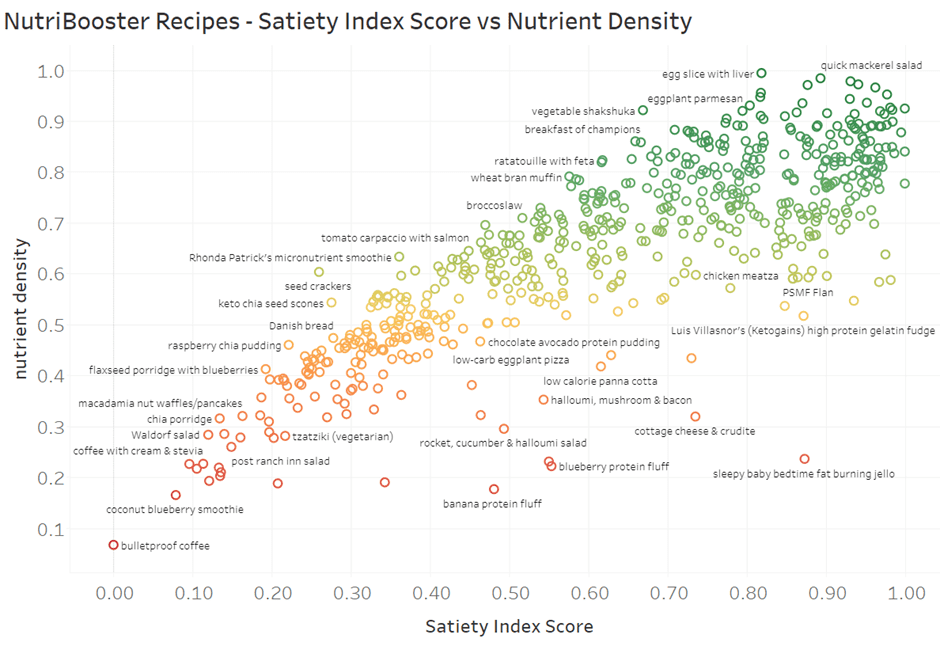
You can check out the interactive Tableau version to explore this chart in detail. To maximise nutrient density and satiety, look for recipes towards the top and right of the chart.
If you find a recipe you like the sound of, you can Google search for the recipe name + ‘Optimising Nutrition’ to find the full recipe as well as the macronutrient and micronutrient details.
You can also use the search box on the Optimiser Nutrition blog here to find the full recipe.
NutriBooster Recipe Books
Our complete database of 600+ NutriBooster recipes is embedded in our Nutrient Optimiser software, which we use in our Macros Masterclasses and Micros Masterclasses to guide people to optimise their nutrient intake and move towards their goals and preferences.
For those not in our classes, we have developed a range of Nutribooster recipe books tailored toward a wide variety of different goals and preferences.
If you’re interested in learning more about our NutriBooster recipe books, we’ve included a summary in the table below. To purchase, click on the link in the left-hand column.
| Goal | Purpose |
| Fat Loss | These recipes are designed for rapid fat loss and provide plenty of micronutrients to minimise cravings, plenty of protein to optimise satiety and prevent muscle loss, and modest energy from carbs and dietary fat to lower blood glucose. This allows you to feel satiated while restricting calories, so you can use body fat for fuel. |
| Maximum Nutrient Density | These are the most nutrient-dense recipes we have. We designed them to pack all the micronutrients you need into your calorie budget. |
| Low-Carb & Blood Sugar | This book is designed for someone looking to stabilise blood sugars and maintain weight while prioritising nutrients on a low-carb diet. Ideal for someone with diabetes or anyone who enjoys fewer carbs. |
| Blood Sugar & Fat Loss | This book is designed for someone with elevated blood sugars and body fat to lose who is looking to optimise their nutrient density. |
| Bodybuilders | We designed this book for someone looking to gain muscle without increasing body fat excessively. These recipes provide plenty of micronutrients with adequate energy to support your workouts, but not so much that you end up ‘dirty bulking’. |
| High Protein:Energy | This book was designed with a high protein:energy ratio for aggressive fat loss. These recipes are ideal for a short-term Protein-Sparing Modified Fast-style (PSMF) diet. |
| Nutritional Keto | We designed this book for someone who wants to optimise their nutrient density and enjoys eating ‘keto’ but does not require therapeutic ketone levels. |
| Therapeutic Keto | This book was designed for people targeting therapeutic ketone levels for conditions like epilepsy, cancer, Alzheimer’s, or Parkinson’s. |
| Plant-Based | These are the most nutrient-dense plant-based (vegan) recipes available. |
| Vegetarian | These are the most nutrient-dense vegetarian meals available. |
| Low-Carb Vegetarian | These are the most nutrient-dense low-carb vegetarian meals available! You can use them to stabilise blood sugars. |
| Lacto Vegetarian | These are the most nutrient-dense lacto-vegetarian (i.e., no meat, seafood, or eggs) recipes available! |
| Maintenance | This book was designed so you can maintain your weight and optimise your nutrient intake to live a healthy and energised life. |
| Pescatarian | These are the most nutrient-dense pescatarian recipes (i.e., vegetarian plus seafood). |
| Egg-Free | These are the most nutrient-dense egg-free meals. |
| Dairy-Free | The most nutrient-dense dairy-free meals. |
| Egg- & Dairy-Free | These are the most nutrient-dense meals without eggs or dairy. |
| Athletes & Bulking | We designed these recipes to provide you with the energy and nutrients you need to support your activity, growth, and recovery. |
| Meat-Based | These are the most nutrient-dense meals that contain meat (i.e., beef, pork, chicken, etc.). |
| Immunity | We designed these recipes around immune-boosting nutrients like iron, selenium, zinc, potassium, and vitamins A, C, and D. |
| Cancer (Weight Loss & Nutrient Density) | This book was designed for someone with cancer who requires less glutamic acid and methionine and is interested in optimising nutrient density and satiety to lose weight. |
| Cancer (Weight Maintenance) | These recipes were designed for someone with cancer who requires less glutamic acid and methionine and is trying to maintain a healthy weight. |
| Cancer (Weight Gain) | We designed these recipes to provide less glutamic acid and methionine for someone with cancer who still needs plenty of energy to gain weight after or during treatment. |
| Smoothies | The most nutritious smoothies for quick and easy meals on the go! |
| Low Oxalate | These are the most nutrient-dense NutriBooster recipes that minimise oxalate intake. |
| Low FODMAP | These recipes were designed to maximise nutrient density and satiety while avoiding high-FODMAP foods. |
| Low Histamine | This book was designed to maximise nutrient density as much as possible while minimising histamine-containing ingredients. |
| Low Fat | Ideal for people who prefer a low-fat diet or need to refill their glycogen stores quickly when blood sugars are low or after a workout. |
Each book contains 33 recipes plus additional links to 100+ secret recipes that align with the goal you’ve chosen. When you purchase one of the books, you will receive:
- an e-book that you can take with you anywhere on your phone or tablet with the most nutritious meals optimised for your goal;
- a secret link index on our website to 100+ of the most nutrient-dense recipes optimised for your goal so you never run out of nutritious ideas to try;
- a full micronutrient breakdown of each recipe showing its vitamin, mineral, essential fatty acid, and amino acid content;
- access to all recipes pre-logged in Cronometerfor your convenience; and
- a list of the most popular nutrient-dense foods that align with your goal.
If you like numbers, the table below lists each NutriBooster recipe book’s average macronutrient split, respective protein:energy (P:E) ratio, and Nutrient Density (ND) Score. The links in the Title column take you to the micronutrient profiles.
| Title | Protein | Fat | Net Carb | Fibre | ND Score |
| Maximum Nutrient Density | 51% | 30% | 14% | 4% | 91.4% |
| Dairy-Free | 51% | 31% | 13% | 5% | 91.0% |
| Egg-Free | 52% | 30% | 14% | 5% | 90.0% |
| Egg & Dairy Free | 51% | 31% | 13% | 5% | 89.8% |
| Pescatarian | 51% | 31% | 14% | 5% | 89.6% |
| Fat Loss | 60% | 24% | 12% | 4% | 88.2% |
| Meat-Based | 50% | 36% | 11% | 4% | 85.8% |
| Low Oxalate | 50% | 35% | 11% | 4% | 82.9% |
| Bodybuilders | 32% | 36% | 25% | 6% | 82.4% |
| Immunity | 38% | 25% | 26% | 10% | 80.6% |
| Blood Sugar & Fat Loss | 37% | 53% | 5% | 4% | 78.8% |
| Vegetarian | 32% | 32% | 28% | 8% | 76.1% |
| High Protein:Energy | 68% | 22% | 7% | 4% | 75.0% |
| Low-Carb Vegetarian | 32% | 44% | 18% | 6% | 74.5% |
| Maintenance | 24% | 38% | 31% | 7% | 74.0% |
| Lacto Vegetarian | 28% | 29% | 35% | 8% | 71.2% |
| Athletes & Bulking | 21% | 30% | 40% | 9% | 69.1% |
| Low FODMAP | 39% | 45% | 11% | 4% | 69.0% |
| Cancer (Weight Loss) | 33% | 33% | 24% | 10% | 68.3% |
| Low Histamine | 36% | 45% | 13% | 6% | 68.3% |
| Autoimmune | 35% | 42% | 17% | 6% | 67.6% |
| Low-Carb & Blood Sugar | 25% | 66% | 5% | 4% | 66.5% |
| Low-Fat | 30% | 15% | 46% | 9% | 65.0% |
| Cancer (Maintenance) | 28% | 35% | 27% | 10% | 64.9% |
| Plant-Based | 21% | 35% | 35% | 9% | 64.5% |
| Nutritional Keto | 19% | 71% | 5% | 5% | 57.0% |
| Therapeutic Keto | 12% | 79% | 5% | 4% | 43.8% |
| Cancer (Fat Gain) | 10% | 65% | 18% | 7% | 40.5% |
The chart below shows where each NutriBooster recipe book sits on the carbs-vs-fat spectrum. Again, you can check out the interactive Tableau version here for more details.
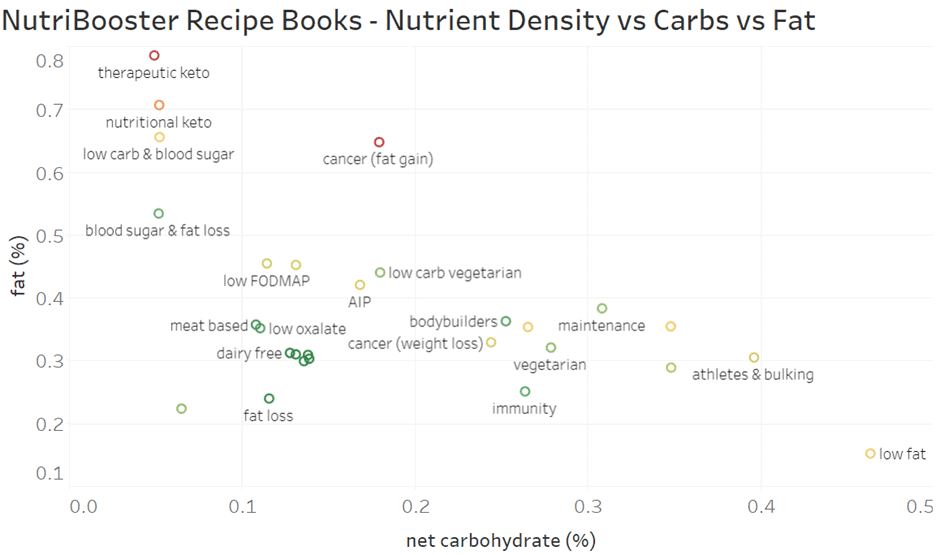
The following chart shows how each recipe book ranks on the nutrients-vs-energy landscape. For the full interactive version of the chart below, click here.
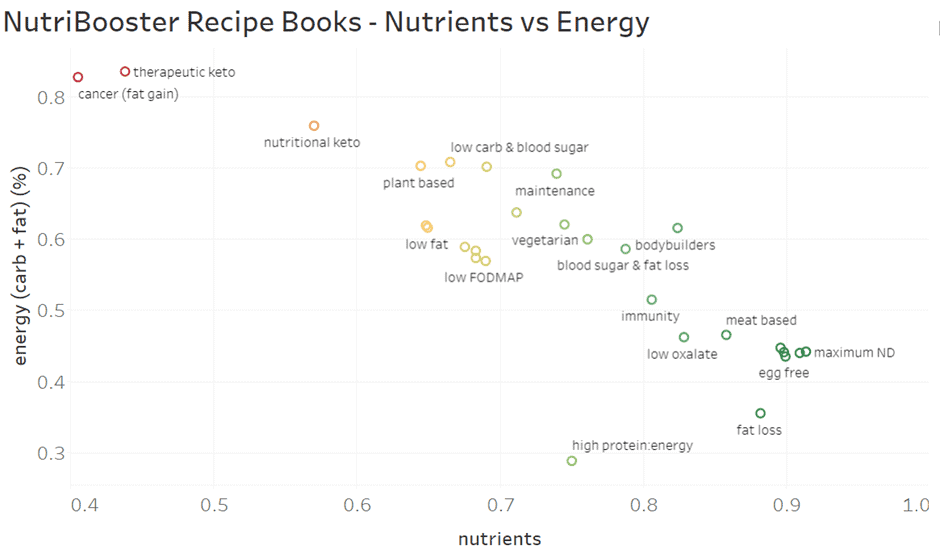
If you’re a part of our Optimising Nutrition Community, you can also check out a sample of each recipe book here.
More
- Satiety Index
- High Satiety Index Foods: Which Ones Will Keep You Full with Fewer Calories?
- How to Maximise Satiety Per Calorie (Across the Whole Day, Every Day)
- Satiety: How to Lose Weight with Less Hunger
- What Is Nutrient Density?
- Nutrient-Dense Meals and Recipes
- The Most Nutrient-Dense Foods – Tailored to Your Goals and Preferences
- Macros Masterclass
- Micros Masterclass


